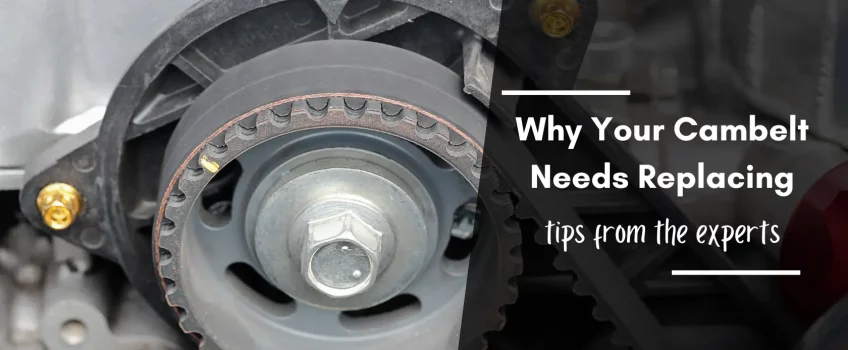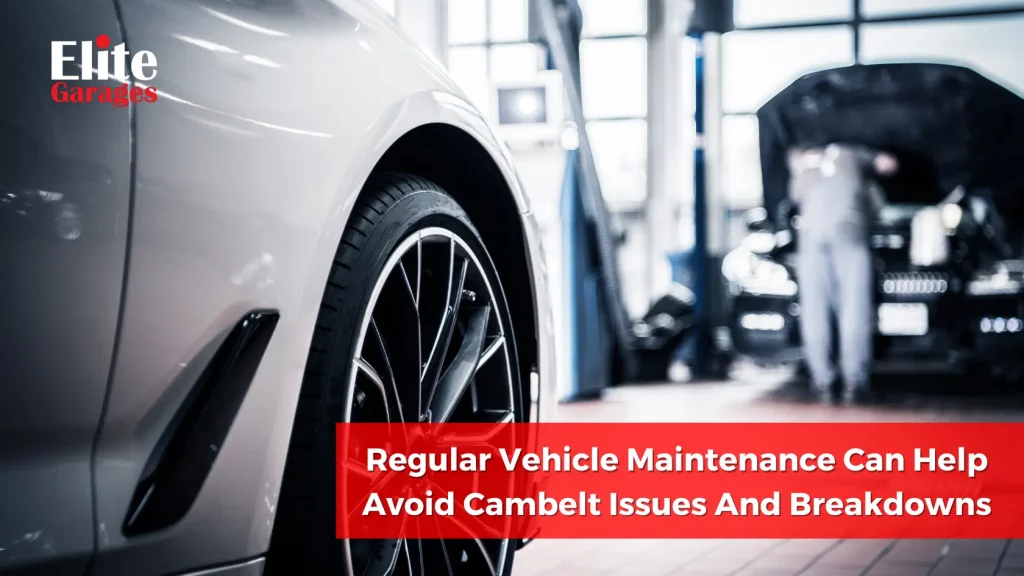
Cambelts And Cars: Valuable Insight You Can’t Ignore
When it comes to maintaining your vehicle, the cambelt, also known as the timing belt, is often overlooked. However, this small yet crucial component is responsible for keeping your engine running smoothly and efficiently. Without it, you are not going anywhere! In this comprehensive guide, we look at when it’s time for a cambelt replacement and what could happen if you don’t.
What Does A Cambelt Do?
First, let’s understand what a cambelt is and what it does. The cambelt is a rubber belt that connects the crankshaft to the camshaft in your engine. The camshaft is responsible for opening and closing the engine’s valves, while the crankshaft converts the up and down motion of the pistons into rotational motion. The cambelt synchronises the rotation of these two parts, ensuring that the engine’s valves open and close at the right time.
Is A Timing Chain The Same As A Cambelt?
Contrary to what some may think, a timing chain is not the same as a cambelt. While both belts are responsible for synchronising the rotation of the crankshaft and camshaft, a timing chain is typically made from metal links rather than rubber.
Also, cambelts are placed outside the engine whereas timing chains are most often inside and lubricated by the engine oil. While some manufacturers have switched to metal timing chains, most cars still rely on ribbed rubber belts.
If you don’t know whether your vehicle has a timing chain or a cambelt, check your vehicle handbook or call your nearest Elite Garage for assistance.
At What Mileage Should I Replace My Cambelt?
Most manufacturers recommend replacing the cambelt every 60,000 to 100,000 miles or every 5-7 years, whichever comes first. However, this can vary depending on the make and model of your vehicle, so it’s always best to check your owner’s manual for specific recommendations. Remember to treat the manufacturer’s intervals as the maximum frequency as it’s safer to get it done sooner, especially considering the damage it can cause if you don’t.
What Happens If A Cambelt Breaks?
Your car’s cambelt won’t last forever; with increasing wear, it becomes more and more prone to breaking. If the cambelt snaps while the engine is running, it can cause the valves to collide with the pistons, resulting in bent valves and potentially damaged pistons and cylinder walls.
Whether a snapped cambelt results in serious engine damage or not depends on the type of engine in your car. A non-interference configuration is far safer since the pistons and valves do not encroach on each other’s space, thereby shielding against any extensive damage.
However, if you have an interference engine, the piston and valve movement can result in catastrophic consequences for both parts as they repeatedly collide with each other; causing severe issues requiring costly repairs. You can avoid all of this by simply adhering to the recommended intervals for cambelt replacement.
What Are The Signs Of A Worn Timing Belt?
While all vehicle components require maintenance, it’s particularly important to pay attention to your car’s timing belt. Unfortunately, there aren’t always clear signs that a cambelt has reached the end of its life and even experts may have trouble diagnosing it without a deeper dive. However, as many people have reported similar signs that a replacement is imminent, we’ve outlined the main indicators in the next section.
Squealing or Chirping Noises When The Car Is Running
When you first start your vehicle and the engine is cold, a fault belt may occasionally result in loud noises. This could be squealing, hissing, grinding, rattling, chirping or even a deep rumble. A screeching belt with a squealing noise is a telltale sign of wear and tear which often requires a replacement.
If the belt was recently installed and you notice a squeal, it could be a loose belt and simply needs to be adjusted. Either way, it never hurts to have an expert look at the condition of your timing belt in the process. The problem with belt noises is that they often disappear when revving the car so they aren’t always easy to identify.
Difficulty Starting The Car
If your vehicle has cambelt issues, it may struggle to start altogether. This happens when the timing belt connecting the camshaft and crankshaft has broken; consequently, the camshaft won’t rotate even if you turn on the crankshaft. To check, observe whether or not your camshaft turns when you activate your crankshaft. If nothing moves – that’s a sign of a broken cambelt!
Visible Cracks Or Fraying On The Belt
As you would for your tyre tread, a good way to check your cambelt is to perform a visual check. You can usually tell if a belt is worn out by looking at the underside. If it appears glossy or glazed, the rubber material has hardened and will no longer be able to provide flexibility as needed.
If you notice cracking or fraying, it’s best to replace it right away. To further test the condition of a timing belt, gently press a fingernail or screwdriver tip onto the surface. If no impression is left behind, the rubber has become too stiff and should also be replaced as soon as possible.
Since not all cars are the same, some cambelts are more difficult to get to so we highly recommend asking a professional to perform a visual and physical check.
A Noticeable Decrease In Power Or Performance
As the cambelt degrades over time, it won’t be able to rotate normally and this can lead to a decrease in power or performance. But, unlike new brakes or other replacement parts, you may not notice any difference in the way your car drives. Occasionally your car may struggle to accelerate quickly, move slower than usual or just seem sluggish in general. If you regularly service your car and you notice these signs, you should have your cambelt inspected right away.
Preventative Measures
It’s imperative to keep up with regular vehicle maintenance to ensure safe driving. During servicing, an experienced technician will take note of any signs of wear and tear on the cambelt. If they recommend a replacement, it is best not to hesitate as following their advice can prevent any future damage that could have been avoided.
Replacing your cambelt is generally a smarter decision than trying to repair it unless you are stranded with no help around and need something temporary to get you back home. Investing in cambelt replacement now will save you the headache and unnecessary expenses down the road.

How Much Does A Cambelt Cost In The UK?
Labour charges will take up the bulk of the cost as the process involves removing many components to access the cambelt. To find a good timing belt price in the UK, contact Elite Garages as this is one of many areas we specialise in.
While you could shop around, the average price for a cambelt replacement is £350 but it could vary between £200 and £1,200*. Please take note that the pricing may depend on the service centre, the type of vehicle and the amount of labour it requires.
For more accurate information based on your vehicle, contact any of our 16 service centres across the UK, including Elite Garages Bournemouth, Brighton, Caterham, Salisbury, Portsmouth, Haywards Heath, Shaftesbury or Newport.
Conclusion
Replacing your cambelt is an important part of maintaining your vehicle. It’s essential to keep an eye out for the signs of a worn cambelt and to follow the manufacturer’s recommendations for replacement. If you notice any of the tell-tale signs, don’t hesitate to book an appointment with a certified vehicle technician as soon as possible to avoid costly engine damage.
The best way to avoid paying a small fortune and a breakdown, make sure to get it checked regularly. When it’s time for your next cambelt replacement, bring your vehicle to an Elite Garage and our expert technicians will ensure that everything runs smoothly and efficiently. They are fully trained and equipped to handle any type of repair job on any make and model.
* Disclaimer: Pricing may vary and it’s best to contact Elite Garages for more information
FAQs
Click the + to read any answer or visit our most FAQ page to review the most frequently asked questions across all our Elite Locations.
If you click on a ‘Category’ or ‘Tag’ link, the page will ‘refresh’ and reload the page showing the top of the page first, you’ll then just need to scroll down to the FAQ section to see the results for the Category or Tag you selected.
Most manufacturers recommend replacing the cambelt every 60,000 to 100,000 miles or every 5-7 years, whichever comes first. Read more about how long a timing belt lasts here..
Your car’s cambelt won’t last forever; with increasing wear, it becomes more and more prone to breaking. If the cambelt snaps while the engine is running, it can cause the valves to collide with the pistons, resulting in bent valves and potentially damaged pistons and cylinder walls. If you don’t change it then it might break!
While all vehicle components require maintenance, it’s particularly important to pay attention to your car’s timing belt. Unfortunately, there aren’t always clear signs that a cambelt has reached the end of its life and even experts may have trouble diagnosing it without a deeper dive. However, click this link to find out the signs that a cambelt replacement is imminent, as many people have reported these as the main indicators.
Most manufacturers recommend replacing the cambelt every 60,000 to 100,000 miles or every 5-7 years, whichever comes first. However, this can vary depending on the make and model of your vehicle, so it’s always best to check your owner’s manual for specific recommendations. Remember to treat the manufacturer’s intervals as the maximum frequency as it’s safer to get it done sooner, especially considering the damage it can cause if you don’t
About Us
Opening Times
Saturday : 8:30–4:00
Sunday : closed
More Information
Contact UsCustomer Information Pack
Check MOT Due Date
Free MOT reminder
Careers
Legal Information
Recent Posts
- Want to Prevent Exhaust Damage and Reduce Emissions?
- Regular Car Maintenance: Joe Achilles Tests Elite Garages’ 250,000-Mile BMW
- Clutch Replacement Near Me: A Comprehensive Guide for UK Drivers
- Antifreeze Coolant: What It Is, How It Works, and When to Use It
- MOT in Brighton: Your Essential Guide to Testing, Servicing and Tyre Safety


